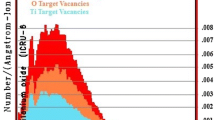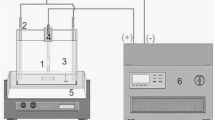Abstract
This study seeks to determine the best compromised parameters for photoluminescence performance and hydrophilicity of nitrogen-doped titanium dioxide coatings deposited on glass substrates using radio frequency reactive magnetron sputtering. Rf power (W), process pressure (mtorr), Ar/O2/N2 flow ratios and substrate temperature (°C) were optimized with reference to the structure and photocatalytic characteristics of TiO2. An L9 (34) orthogonal array, the signal-to-noise ratio and analysis of variance were employed for determination of the compromise deposition settings of nitrogen-doped titanium dioxide thin films, annealed in Ar ambient (10 mtorr) at temperatures of 250, 350 and 450 °C, for a period of 30 min. The results demonstrate that for Ar/O2/N2 flow ratios of 80/20/0, 75/20/5, 70/20/10, and 65/20/15, the respective corresponding methylene blue absorbance is 0.412, 0.406, 0.385, and 0.355, which depicts a greater photocatalytic activity with a larger N2 flow ratio. For the morphological properties, the nitrogen-doped titanium dioxide films with a larger N2 flow ratio show a homogenous structure, smaller grain sizes and more spherical particles with Ra roughness of 1.394–0.362 nm. The effects of annealing temperature, duration of ultraviolet and visible light irradiation were also analyzed. The films annealed at higher temperature (450 °C) under ultraviolet and visible light irradiation of 240 min exhibit coexistence of the anatase (101) and rutile (004) structures, which appears to imbue the nitrogen-doped titanium dioxide film with greater photocatalytic activity and photo-induced hydrophilicity.
Graphical Abstract
Novelty Statement
1. This study seeks to determine the best compromised parameters for photoluminescence performance and hydrophilicity.
2. The ANOVA results show that the rf power has the major effect on methylene blue (MB) absorbance and the process pressure ranks the second.
3. This study determines the effect of Ar/O2/N2 flow ratios and post annealing treatment on the morphology, hydrophilicity and photocatalytic activity of N-TiO2 thin films. The results demonstrate that a greater photocatalytic activity for N-TiO2 thin films can be achieved by using a greater N2 flow ratio.
4. The film that is annealed at 450 °C exhibits the coexistence of the anatase (101) and rutile (004) structures, which appears to imbue the N-doped TiO2 film with greater photocatalytic activity and photoinduced hydrophilicity under UV and visible light illumination.












Similar content being viewed by others
References
Wang SS, Shiou FJ, Chiou KL, Tsao CC, Hsu CY (2014) Photocatalytic performance of TiO2 thin films deposited on soda-lime glass and the effect of post-annealing on their properties. J Comput Theor Nanosci 11:1–7
Mamane H, Horovitz I, Lozzi L, Camillo DD, Avisar D (2014) The role of physical and operational parameters in photocatalysis by N-doped TiO2 sol–gel thin films. Chem Eng 257:159–169
Liu B, Wen L, Zhao X (2008) The structure and photocatalytic studies of N-doped TiO2 films prepared by radio frequency reactive magnetron sputtering. Sol Energ Mat Sol C 92:1–10
Wan L, Li JF, Feng JY, Sun W, Mao ZQ (2007) Improved optical response and photocatalysis for N-doped titanium oxide (TiO2) films prepared by oxidation of TiN. Appl Surf Sc 253:4764–4767
Asahi R, Ohwaki T, Aoki K, Taga Y (2001) Visible-light photocatalysis in nitrogen-doped titanium oxides. Science 293:269–271
Irie H, Washizuka S, Yoshino N, Hashimoto K (2003) Visible-light induced hydrophilicity on nitrogen-substituted titanium dioxide films. Chem Commun 11:1298–1299
Nejand BA, Sanjabi S, Ahmadi V (2010) The effect of sputtering gas pressure on structure and photocatalytic properties of nanostructured titanium oxide self-cleaning thin film. Vacuum 85:400–405
Irie H, Washizuka S, Watanabe Y, Kako T, Hashimoto K (2005) Photoinduced hydrophilic and electrochemical properties of nitrogen-doped TiO2 films. J Electrochem Soc 152(11):E351–E356
Chan MH, Lu FH (2009) Characterization of N-doped TiO2 films prepared by reactive sputtering using air/Ar mixtures. Thin Solid Films 518:1369–1372
Li ZG, Miyake S (2009) Characteristics of N-doped TiO2 thin films grown on unheated glass substrate by inductively coupled plasma assisted dc reactive magnetron sputtering. Appl Surf Sci 255:9149–9153
Serio S, Jorge MEM, Nunes Y, Barradas NP, Alves E, Munnik F (2012) Incorporation of N in TiO2 films grown by DC-reactive magnetron sputtering. Nucl Instrum Meth B 273:109–112
Taguchi G, Elsayed EA, Hsaing T (1989) Quality Engineering in Production Systems. McGraw-Hill, New York
Cheng TC, Yao KS, Hsieh YH, Hsieh LL, Chang CY (2010) Optimizing preparation of the TiO2 thin film reactor using the Taguchi method. Mater Design 31(4):1749–1751
Huang CH, Tsao CC, Hsu CY (2011) Study on the photocatalytic activities of TiO2 films prepared by reactive RF sputtering. Ceram Int 37:2781–2788
Dhayal M, Jun J, Gu HB, Park KH (2007) Surface chemistry and optical property of TiO2 thin films treated by low-pressure plasma. J Solid State Chem 180:2696–2701
Reddy KM, Reddy CVG, Manorama SV (2001) Preparation, characterization, and spectral studies on nanocrystalline anatase TiO2. J Solid State Chem 158:180–186
Wang C, Hu Q, Huang J, Wu L, Deng Z, Liu Z, Liu Y, Cao Y (2013) Efficient hydrogen production by photocatalytic water splitting using N-doped TiO2 film. Appl Surf Sci 283:188–192
Nejand BA, Sanjabi S, Ahmadi V (2011) Sputter deposition of high transparent TiO2−xNx/TiO2/ZnO layers on glass for development of photocatalytic self-cleaning application. Appl Surf Sci 257:10434–10442
Tomaszewski H, Poelman H, Depla D, Poelman D, DeGryse R, Fiermans L, Reyniers MF, Heynderickx G, Marin GB (2002) TiO2 films prepared by DC magnetron sputtering from ceramic targets. Vacuum 68:31–38
Xu Y, Shen M (2008) Fabrication of anatase-type TiO2 films by reactive pulsed laser deposition for photocatalyst application. J Mater Process Tech 202:301–306
Hsu CY, Lin YC, Kao LM, Lin YC (2010) Effect of deposition parameters and annealing temperature on the structure and properties of Al-doped ZnO thin films. Mater Chem Phys 124:330–335
Sakai M, Nishimura M, Morii Y, Furuta T, Isobe T, Fujishima A, Nakajima A (2012) Reduction of fluid friction on the surface coated with TiO2 photocatalyst under UV illumination. J Mater Sci 47:8167–8173
Zhao L, Han M, Lian J (2008) Photocatalytic activity of TiO2 films with mixed anatase and rutile structures prepared by pulsed laser deposition. Thin Solid Films 516:3394–3398
Author information
Authors and Affiliations
Corresponding authors
Ethics declarations
Conflict of interest
The authors declare that they have no competing interests.
Rights and permissions
About this article
Cite this article
Hu, C., Chiou, A., Yang, C. et al. Best compromise for photocatalytic activity and hydrophilicity: N-doped TiO2 films under UV light. J Sol-Gel Sci Technol 81, 167–176 (2017). https://doi.org/10.1007/s10971-016-4189-7
Received:
Accepted:
Published:
Issue Date:
DOI: https://doi.org/10.1007/s10971-016-4189-7




